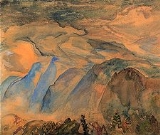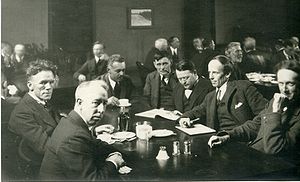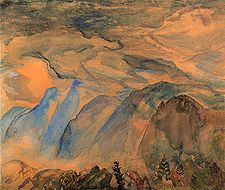
Frederick Varley
Encyclopedia
Frederick Horsman Varley, also known as Fred Varley (January 2, 1881 – September 8, 1969), was a member of the Canadian
Group of Seven
artists.
, England
. He studied art in Sheffield
and in Belgium
. He came to Canada in 1912 on the advice of another Sheffield native (and future Group of Seven member), Arthur Lismer
, and found work at the Grip Ltd.
design firm in Toronto, Ontario.
with C.W. Simpson
, J.W. Beatty
and Maurice Cullen
. Varley came to the attention of Lord Beaverbrook, who arranged for him to be commissioned as an "official war artist." He accompanied Canadian troops in the Hundred Days offensive from Amiens, France to Mons, Belgium. His paintings of combat are based on his experiences at the front. Although he had been enthusiastic to travel to France as a war artist, he became deeply disturbed by what he saw:
Varley's Some Day the People Will Return, shown at the Burlington House
in London and at the Canadian War Memorials Exhibition, is a large canvas depicting a war-ravaged cemetery, suggestive that even the dead cannot escape the destruction.


His and A.Y. Jackson's contribution in the war influenced work in the Group of Seven. They chose to paint Canadian wilderness that had been damaged by fire or harsh climates. Varley's major contribution to art is his work with the Group of Seven. He and Lawren Harris
were the only members of the group to paint portrait
s.
In 1954, along with a handful of artists including Eric Aldwinckle
, he visited the Soviet Union on the first cultural exchange of the Cold War.
He died in Toronto
in 1969. In Markham, Ontario
, the Varley Art Gallery is named after him, as is Fred Varley Drive, a two-lane residential street in Unionville
.
His secure place in the art history
of Canada is verified by the government's decision to reproduce his self-portrait as a 17-cent postage stamp.
Canada
Canada is a North American country consisting of ten provinces and three territories. Located in the northern part of the continent, it extends from the Atlantic Ocean in the east to the Pacific Ocean in the west, and northward into the Arctic Ocean...
Group of Seven
Group of Seven (artists)
The Group of Seven, sometimes known as the Algonquin school, were a group of Canadian landscape painters from 1920-1933, originally consisting of Franklin Carmichael , Lawren Harris , A. Y. Jackson , Franz Johnston , Arthur Lismer , J. E. H. MacDonald , and Frederick Varley...
artists.
Early life
Varley was born in SheffieldSheffield
Sheffield is a city and metropolitan borough of South Yorkshire, England. Its name derives from the River Sheaf, which runs through the city. Historically a part of the West Riding of Yorkshire, and with some of its southern suburbs annexed from Derbyshire, the city has grown from its largely...
, England
England
England is a country that is part of the United Kingdom. It shares land borders with Scotland to the north and Wales to the west; the Irish Sea is to the north west, the Celtic Sea to the south west, with the North Sea to the east and the English Channel to the south separating it from continental...
. He studied art in Sheffield
Sheffield
Sheffield is a city and metropolitan borough of South Yorkshire, England. Its name derives from the River Sheaf, which runs through the city. Historically a part of the West Riding of Yorkshire, and with some of its southern suburbs annexed from Derbyshire, the city has grown from its largely...
and in Belgium
Belgium
Belgium , officially the Kingdom of Belgium, is a federal state in Western Europe. It is a founding member of the European Union and hosts the EU's headquarters, and those of several other major international organisations such as NATO.Belgium is also a member of, or affiliated to, many...
. He came to Canada in 1912 on the advice of another Sheffield native (and future Group of Seven member), Arthur Lismer
Arthur Lismer
Arthur Lismer, CC was an English-born Canadian painter and member of the Group of Seven.-Early life:At age 13 he apprenticed at a photo-engraving company. He was awarded a scholarship, and used this time to take evening classes at the Sheffield School of Arts from 1898 until 1905...
, and found work at the Grip Ltd.
Grip Ltd.
Grip was the name of the Toronto, Ontario design firm that was home to many of Canada's premier designers and painters during the first half of the 20th century....
design firm in Toronto, Ontario.
War artist
Beginning in January 1918, he served in the First World WarWorld War I
World War I , which was predominantly called the World War or the Great War from its occurrence until 1939, and the First World War or World War I thereafter, was a major war centred in Europe that began on 28 July 1914 and lasted until 11 November 1918...
with C.W. Simpson
Charles Walter Simpson
Charles Walter Simpson was a Canadian artist.Simpson was born in Montreal, Quebec.-War artist:Beginning in January 1918, he served with Canadian forces in the First World War. Simpson came to the attention of Lord Beaverbrook, who arranged for him to be commissioned as an "official war artist"...
, J.W. Beatty
John William Beatty
John William Beatty was a Canadian painter who was a forerunner in the movement which became the Group of Seven in 1920.-Early Painting Life:...
and Maurice Cullen
Maurice Galbraith Cullen
Maurice Galbraith Cullen was a Canadian artist.Cullen was born June 6, 1866 in St. John's, Newfoundland.-War artist:Beginning in January 1918, Cullen served with Canadian forces in the First World War. He came to the attention of Lord Beaverbrook, who arranged for him to be commissioned as an...
. Varley came to the attention of Lord Beaverbrook, who arranged for him to be commissioned as an "official war artist." He accompanied Canadian troops in the Hundred Days offensive from Amiens, France to Mons, Belgium. His paintings of combat are based on his experiences at the front. Although he had been enthusiastic to travel to France as a war artist, he became deeply disturbed by what he saw:
Varley's Some Day the People Will Return, shown at the Burlington House
Burlington House
Burlington House is a building on Piccadilly in London. It was originally a private Palladian mansion, and was expanded in the mid 19th century after being purchased by the British government...
in London and at the Canadian War Memorials Exhibition, is a large canvas depicting a war-ravaged cemetery, suggestive that even the dead cannot escape the destruction.
Group of Seven


His and A.Y. Jackson's contribution in the war influenced work in the Group of Seven. They chose to paint Canadian wilderness that had been damaged by fire or harsh climates. Varley's major contribution to art is his work with the Group of Seven. He and Lawren Harris
Lawren Harris
Lawren Stewart Harris, CC was a Canadian painter. He was born in Brantford, Ontario and is best known as a member the Group of Seven who pioneered a distinctly Canadian painting style in the early twentieth century. A. Y. Jackson has been quoted as saying that Harris provided the stimulus for the...
were the only members of the group to paint portrait
Portrait
thumb|250px|right|Portrait of [[Thomas Jefferson]] by [[Rembrandt Peale]], 1805. [[New-York Historical Society]].A portrait is a painting, photograph, sculpture, or other artistic representation of a person, in which the face and its expression is predominant. The intent is to display the likeness,...
s.
In 1954, along with a handful of artists including Eric Aldwinckle
Eric Aldwinckle
Eric Aldwinckle was a Canadian war artist, designer and illustrator.Born in England in 1909 but sent to Canada in his teens, he apprenticed with printers in Toronto in the 1920’s and learned the graphic design trade along the way...
, he visited the Soviet Union on the first cultural exchange of the Cold War.
He died in Toronto
Toronto
Toronto is the provincial capital of Ontario and the largest city in Canada. It is located in Southern Ontario on the northwestern shore of Lake Ontario. A relatively modern city, Toronto's history dates back to the late-18th century, when its land was first purchased by the British monarchy from...
in 1969. In Markham, Ontario
Markham, Ontario
Markham is a town in the Regional Municipality of York, located within the Greater Toronto Area of Southern Ontario, Canada. The population was 261,573 at the 2006 Canadian census...
, the Varley Art Gallery is named after him, as is Fred Varley Drive, a two-lane residential street in Unionville
Unionville, Ontario
Unionville is a suburban village in Markham, Ontario, Canada. It is located 33 km northeast of downtown Toronto and 4 km east of southern Richmond Hill. Unionville is located between Woodbine Avenue as the western limit, alongside the Rouge River leading to McCowan Road as the eastern...
.
His secure place in the art history
Art history
Art history has historically been understood as the academic study of objects of art in their historical development and stylistic contexts, i.e. genre, design, format, and style...
of Canada is verified by the government's decision to reproduce his self-portrait as a 17-cent postage stamp.
See also
- Canadian official war artistsCanadian official war artistsCanadian official war artists create a visual account of war by showing its impact as men and women are shown waiting, preparing, fighting, suffering, celebrating, These were a select group of artists who were employed on contract, or commissioned to produce specific works during the First World...
- Group of SevenGroup of Seven (artists)The Group of Seven, sometimes known as the Algonquin school, were a group of Canadian landscape painters from 1920-1933, originally consisting of Franklin Carmichael , Lawren Harris , A. Y. Jackson , Franz Johnston , Arthur Lismer , J. E. H. MacDonald , and Frederick Varley...
- Tom ThomsonTom ThomsonThomas John Thomson , also known as Tom Thomson, was an influential Canadian artist of the early 20th century. He directly influenced a group of Canadian painters that would come to be known as the Group of Seven, and though he died before they formally formed, he is sometimes incorrectly credited...
- War artWar artWar art is considered a genre of art. It is characterized by war, military subjects and war activities, as part of the wider field of military art. The distinction between war and military art is not clear-cut. The works described as war art represent a broad range of subject matter and styles....
- War artistWar artistA war artist depicts some aspect of war through art; this might be a pictorial record or it might commemorate how "war shapes lives." War artists have explored a visual and sensory dimension of war which is often absent in written histories or other accounts of warfare.- Definition and context:A...

